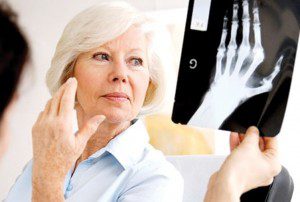By Bradley Weitzner, M.D. – Sarasota Arthritis Centers
 Did you know there are more than 100 types of arthritis? And each type of arthritis is different and, therefore, may call for a different approach to treatment. A trained Rheumatologist can help you navigate through the work up and determine which type you have, and what the best treatment options are for you.
Did you know there are more than 100 types of arthritis? And each type of arthritis is different and, therefore, may call for a different approach to treatment. A trained Rheumatologist can help you navigate through the work up and determine which type you have, and what the best treatment options are for you.
The term “arthritis” stems from the root word “artho” meaning joint, and “itis” meaning inflammation. And although there are many different types—Arthritis can be broken down into two main categories:
1) Osteoarthritis/Degenerative joint disease
2) Systemic Inflammatory Diseases.
What is Osteoarthritis/DJD?
Almost everyone has it or will eventually develop symptoms related to this condition at some point in their lives. All people are born with a certain degree of cartilage which acts as shock absorbers to prevent the bones from pounding together. Unfortunately just like shocks on a car, the cartilage wears down over time, causing the bones to rub together resulting in inflammation and pain. This is generally referred to as osteoarthritis or degenerative changes. And results from years of repetitive “wear and tear” of everyday life, but can be accelerated by major injuries including; car accidents, falls, lifting, or sports related. Other chronic injuries can also result in pain which doesn’t stem from the joint, but structures nearby i.e. tendonitis/bursitis/and neuropathies
What are Systemic Inflammatory Diseases?
“Systemic Inflammatory Disease” refers to the blood stream and as the name suggests, can affect other organs in the body—not just the joints. There is an extensive list, but the most common ones include: Rheumatoid arthritis, Systemic lupus, Gout, Scleroderma, Sjogrens, Psoriatic arthritis, and Ankylosing spondylitis. Systemic Inflammatory Diseases tend to be autoimmune, where the immune cells which typically protect us from bacteria/viruses, get confused and attack our bodies/joints. With these diseases it is crucial to make the diagnosis early and distinguish them from the mechanical damage. That’s because they need to be treated more aggressively. This will not only reduce the pain and swelling, but also slow down the progression of the disease itself, thereby preventing deformities and disability. Even though there are good treatment to these diseases, the damage is permanent, therefore once done it can no longer be reversed.
What are the symptoms of Osteoarthritis?
Symptoms of osteoarthritis, depending on which joint or joints are affected, may include: deep, aching pain; difficulty dressing or combing hair; difficulty gripping objects; difficulty sitting or bending over. Pain is usually worse with activity and at the end of the day. Onset is usually gradual and gets worse with age.
What are the symptoms of Inflammatory Arthritis?
Unlike osteoarthritis, symptoms of rheumatoid arthritis and other inflammatory diseases are often more severe, causing pain, fatigue, loss of appetite, or stiffness. It can come on gradually or start suddenly. One may feel pain and stiffness and experience swelling in the hands, wrists, elbows, shoulders, knees, ankles, feet, jaw, and neck. The joint swelling is persistent and interferes with activities. For example, it can interfere with opening a jar, driving, working, and walking — the very activities that allow us to function in our daily lives. Unlike osteoarthritis, pain tends to be worse in the morning and gets better throughout the day. Also the degree of swelling tends to be greater.
What Causes Arthritis?
Osteoarthritis- caused by loss of cartilage between the bones. Factors that influence this are:
- Age. The longer you live, the more cartilage you will wear away.
- Gender. In general, arthritis occurs more frequently in women than in men.
- Obesity. Being overweight puts extra stress on weight-bearing joints, increasing the speed in which the cartilage is worn down in these joints.
- Work factors. Some jobs that require repetitive movements or heavy lifting can stress the joints and/or cause an injury.
- Injury. Any injury to a joint which significantly damages the cartilage will speed up the progression of developing arthritis in that joint.
Rheumatoid arthritis – The exact cause is unknown but is likely a combination of a genetic predisposition and an environmental factor.
Gout – is caused by excessive uric acid in the blood stream.
Two case reports/Patient Testimonials
In Florida, we treat a lot of elderly patients. Most of who assume their arthritic pain is because of their age. However we see many patients who, although are older, their arthritis is coming from the second category—a systemic arthritic disease.
For example, we had a patient who was told they needed a shoulder and hip replacement, however, once diagnosed with Polymyalgia Rheumatic (PMR), they were placed on low dose medication and recovered to a great extent. Sure they did have cartilage loss on imaging, but their pain wasn’t stemming from this, and they never needed to undergo surgery.
Another patient, a furniture mover, was struggling with back pain. It was assumed due to his career that it was related to heavy lifting. However, on careful history and examination, the patient revealed his pain/stiffness was worse in the AM and actually got better with moving furniture. Also this patient was found to have large psoriatic plaques and pitting of the nails. A diagnosed of psoriatic arthritis was made, and with proper treatment, his pain subsided and is now symptom free. Coincidently, this is same condition the golfer, Phil Mickelson has. It got so bad he could barely walk. But similar to our patient, with proper treatment, he was able to go back on tour again.
How is my Arthritis Diagnosed?
It is important for your doctor to take an informative history and perform a careful physical examination. After which they will likely need to order the appropriate images of the affected joints and obtain blood tests. In addition, sometimes fluid can be aspirated from the joint for analysis.
Can Arthritis Be Prevented?
Although it is impossible to prevent arthritis completely, there are steps to take to reduce your risk of developing osteoarthritis. These include:
- Maintaining a healthy weight. Excess weight puts strain on your joints.
- Exercising. Keeping your muscles strong can help protect and support your joints.
- Using joint-protecting devices and techniques at work. Proper lifting and posture can help protect your muscles and joints.
- Eating a healthy diet. A well balanced, nutritious diet can help strengthen your bones and muscles.
Treatment Options
The goal of arthritis treatment is to provide pain relief and increase joint mobility and strength. Depending on the type of arthritis, if it is not treated quickly, it can lead to joint destruction and permanent damage. The key is not to wait too long. One can wear out a knee due to inflammatory arthritis which could have been treated with medication, but now requires surgery.
Non-inflammatory types (e.g., osteoarthritis) are usually treated with NSAIDs (non-steroid anti-inflammatory), pain medications, physi-cal activity, weight loss (if overweight), cortisone/other types of injections, and self-management education.
Inflammatory types (e.g., rheumatoid arthritis) are treated with these modalities as well as disease-modifying anti-rheumatic drugs (DMARDs), and biologics which can slow down the progression and prevent deformities and disability.
Drug Research Studies
The Sarasota Arthritis Research Center has been involved in drug research for over a quarter of a century for patients who have failed with traditional medication or who cannot afford medication. We monitor patients and take care of them throughout the process. We are currently recruiting patients with rheumatoid arthritis and other systemic diseases. Please contact Debbie Bevalqua at 941-366-1244 if you are interested in participating in a drug study.
Experts in the Treatment of Arthritis
Drs. Ronald Weitzner, Richard Yonker, Jeffrey Kaine, Daniel Small, Yoel Drucker, Rober Ikeman, Tatiana Huguenin and Bradley Weitzner are all specialists in the diagnosis and treatment of all forms of arthritis, including: Osteoarthritis, Rheumatoid Arthritis, Juvenile Rheumatoid Arthritis, Gout, Sjogrens, and Osteopororis, among others. All have completed residencies and fellowships in Rheumatology and Internal Medicine and are board certified.
To learn more or to schedule an appointment, please call Sarasota Arthritis Centers at 941-365-0770, or visit our website at www.arthritiscenters.net. Let us put our experience and training to work for you so you can live a normal, healthy life.
Partial excerpts from webmd.com and cdc.gov
Good Samaritan Stephanie
They are still out there… I know it seems hard to believe but they are.
I have to tell you a quick story about a dad, who left his new IPhone 5 in the shopping cart at Publix when he was unloading groceries and kids into a car. I am sure those of you with kids can see this same situation happening. I have a seven year old daughter who is antagonizing her three year old brother and a cart full of groceries. I put my phone in the cart and started to unload, just happy to get all the bags in the car before one of the two kids started crying I jumped in and left.
The next morning it occurred to me, “Shoot, where is my phone?… OH NO I think I left it at the supermarket.” The IPhone has a service in the iCloud called “Find my Phone”. I only know this because the day before, while I was supposed to be working, I was messing around with my new phone and set up the iCloud. Here is where the rubber meets the road. Does “Find my phone” work?
You Bet it Does…
My phone was a gleaming beacon on a map. It was only a few miles away at Bradenton Arthritis. I started to head over there, wondering what I would find. Would I find an employee who stole my phone? Would they be hostile? Would I have to involved the police?
I walked in with my laptop open and was greeted by the staff, I asked one of them if she could help me; “I lost my IPhone yesterday and I think it is here”, Stephanie was a surprised as I was. “Sure it is! I have it right here on my desk.” Stephanie found it, right where I left it in the cart. The store manager said they would put it in a drawer and hopefully someone would show up for it. Stephanie thought “I can do better than that”. She brought it to work the next morning, knowing one of her doctors had a new IPhone and she could keep it charged while waiting for someone to call it so she could figure out who it belonged to. She even looked up the closest Apple store thinking if she couldn’t figure this out, the Apple store should be able to identify who it belonged to. When I walked in, they were online trying to find “me”. After my anxiety lessened we started talking, had a few laughs and I was out the door on my way with my IPhone and a new friend.
I have to tell you what I thought was going to be a rotten day and a big hit to my wallet, turned out to be a refreshing affirmation, that good people are still out there. With a little sympathy and kindness in their hearts, good Samaritans still exist. Show a stranger you care, be that person, be the next good Samaritan.








